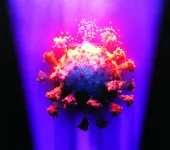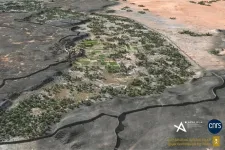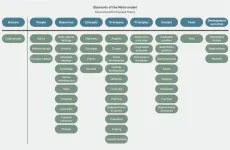(Press-News.org) Barcelona, 10 January 2024 – Mutations, which occur continuously in every cell of our bodies, are a key contributor to cancer, ageing, and neurodegeneration. While exposure to mutagenic chemicals, or mistakes in cellular processes during DNA replication contribute to these mutations, the exact distribution and patterns of these changes across human chromosomes have remained a mystery until now.
Dr. Fran Supek, ICREA researcher and head of the Genome Data Science lab at IRB Barcelona, and Marina Salvadores, PhD student in the same laboratory, have delved into the landscape of DNA mutations, unveiling unexpected patterns that differentiate individuals in terms of mutation risk.
Previous work by the laboratory identified a "genomic spellchecker," a DNA repair mechanism devoted to reducing mutation risks in key parts of human chromosomes. Building upon these findings, the current study aimed to determine whether mutation risk varies between individuals and, if so, to identify the mechanisms driving these differences.
“This research not only expands our understanding of the factors influencing mutation rate distribution but it also has significant implications for cancer evolution, therapeutic strategies, and advancements in regenerative medicine,” explains Dr. Supek.
A genomic ‘big data’ analysis
To address these questions, the researchers conducted a comprehensive analysis of genome sequences from over 4,000 tumours from various organs. Unlike previous studies focusing on tissue-specific mutation risks, this study specifically targeted individual differences in susceptibility to mutations.
Employing a genomic "big data" approach, the team used machine learning algorithms to identify recurrent patterns across chromosome segments. They discovered 13 distinct patterns, with 10 corresponding to different types of tissue. Unexpectedly, the remaining three patterns were observed in almost all the tissues, thereby revealing that the density of mutations in specific genes varies significantly between individuals.
Connecting the dots
To understand these unexpected patterns, the researchers examined additional data, including gene expression and genetic aberrations, in cancer cells. The analysis uncovered a surprising correlation between increased cell proliferation and alterations in mutation risks. Disruptions in two crucial tumour-suppressor genes, TP53 and RB1, known to regulate the cell division cycle, were identified as key influencers, causing changes in the risk of mutations across chromosomes.
These chromosome segments not only presented altered mutation risks but also large-scale "remodelling" of usually inactive chromosomal regions. “This remodelling, which is correlated with increased cell proliferation, mirrored the changes in mutation risks, providing unique insight into the interplay between mutations and epigenetic alterations,” explains Marina Salvadores, first author of the study.
Decoding cancer evolution
The implications of this study extend beyond fundamental research. By identifying the cancer-causing genes most affected by changes in mutation risk between individuals, the scientists have provided a roadmap for anticipating the trajectory of cancer evolution. This knowledge is especially relevant for anticipating responses to cancer treatment, as it can help to predict the development of drug-resistance mutations in tumours.
The study also offers valuable insights into the epigenetics of human cells, highlighting that the epigenome undergoes dramatic changes in response to increased or disrupted cell proliferation. This understanding has potential implications for cell reprogramming and regenerative medicine, opening up new avenues for future research and therapeutic interventions.
This study has received funding from the ERC and the Spanish Ministerio de Ciencia e Innovación.
END
Unravelling individual differences in DNA mutation risks
2024-01-10
ELSE PRESS RELEASES FROM THIS DATE:
Scientists discover how ultraviolet light degrades coronavirus
2024-01-10
New research has revealed how light can be used to destroy infectious coronavirus particles that contaminate surfaces. Scientists are interested in how environments, such as surgeries, can be thoroughly disinfected from viruses such as SARS-CoV-2 that caused the COVID-19 pandemic.
SARS-CoV-2 viral particles are composed of a core of nucleic acid chains that contain the genetic information of the virus, surrounded by a lipid membrane with proteinous spikes sticking out. Each component is necessary for infection.
Researchers from the University of Southampton investigated how ultraviolet laser light destroys the virus by impacting each of these critical components. By using a specialised ...
Tackling the effect of climate change on diarrheal diseases
2024-01-10
Diarrhoea is, globally, the second largest cause of death for children under 5. Contributing to more than 500,000 deaths, only pneumonia kills more children each year. Climate change, driving increased flooding and droughts, threatens the fragile progress made in reducing the burden of diarrheal disease over the past decades. Together with the Amsterdam Institute of Global Health and Development, Amsterdam UMC is set to lead a global consortium in the hunt for improved interventions.
"We see that the impact of climate change on diseases transmission depends on the constantly changing interaction between climate events, local ...
Do symptoms of post-traumatic stress disorder facilitate substance use as a coping method among children after a natural disaster?
2024-01-10
In a survey-based study of 3rd to 12th grade students in Puerto Rico after 2017’s Hurricane Maria, certain symptoms of post-traumatic stress disorder (PTSD) were linked with a higher risk of using drugs or alcohol.
The study, which is published in the Journal of Traumatic Stress, included 91,732 youths who completed a survey 5–9 months after Hurricane Maria made landfall in Puerto Rico. Associations between PTSD symptoms and substance use were examined using a network conceptualization, which views disorders as stemming from interactions ...
Microplastics affect soil fungi depending on drought conditions
2024-01-10
Moisture levels in the soil can impact the effects that microplastic pollution has on soil fungi, according to new research published in Environmental Microbiology.
By studying soil samples mixed with microplastics under different conditions, investigators found that when soil is well-watered, toxic chemicals in microplastics can leach into the soil and hinder soil fungal richness. With dry soil, however, the leaching of water-extractable chemicals is less pronounced and therefore less impactful on soil fungal structure.
The researchers also noted that under dry conditions, microplastics help soil hold water for longer, which could help ...
Is a commonly used screening tool for cognitive impairment accurate in diverse populations?
2024-01-10
A screening tool often used in primary care clinics to detect cognitive impairment has shortcomings when applied to ethnically and linguistically diverse older adults, according to a study published in the Journal of the American Geriatrics Society.
The study looked to see whether currently published English and Spanish cut points for cognitive impairment in the Montreal Cognitive Assessment (MoCA) are appropriate in diverse community-based adults aged 65 years or older with cognitive concerns in the Bronx, New York. There were 231 participants (43% ...
Do individual-level mental health interventions improve employees’ wellbeing?
2024-01-10
Many businesses are making efforts to promote workers’ wellbeing, and numerous interventions are available at the individual and organizational levels. New research published in the Industrial Relations Journal found no evidence that individual-level mental wellbeing interventions like mindfulness, resilience and stress management, relaxation classes, and wellbeing apps benefit employees.
The study was based on survey data from 46,336 workers in 233 organizations in the UK. Across multiple subjective wellbeing indicators, participants in individual-level mental wellbeing interventions appeared no better off than other workers.
The study’s ...
Discovery of immense fortifications dating back 4,000 years in north-western Arabia
2024-01-10
The North Arabian Desert oases were inhabited by sedentary populations in the 4th and 3rd millennia BCE. A fortification enclosing the Khaybar Oasis—one of the longest known going back to this period—was just revealed by a team of scientists from the CNRS1 and the Royal Commission for AlUla (RCU). This new walled oasis is, along with that of Tayma, one of the two largest in Saudi Arabia. While a number of walled oases dating back to the Bronze Age had already been documented, this major discovery sheds new light on human occupation in north-western Arabia, and provides ...
Higher viral load during HIV infection can shape viral evolution
2024-01-10
A new paper in Molecular Biology and Evolution, published by Oxford University Press, finds that HIV populations in people with higher viral loads also have higher rates of viral recombination. In effect, the more HIV in the blood, the easier it is for the virus to diversify.
One of the reasons HIV has historically been so difficult to combat is the virus’s exceptionally high rate of recombination. Recombination enables the exchange of genetic information across strains of the virus and drives HIV’s evolution within people. This genetic exchange ...
More than 900 chemicals, many found in consumer products and the environment, display breast-cancer causing traits
2024-01-10
With tens of thousands of synthetic chemicals on the market, and new ones in development all the time, knowing which ones might be harmful is a challenge both for the federal agencies that regulate them and the companies that use them in products. Now scientists have found a quick way to predict if a chemical is likely to cause breast cancer based on whether the chemical harbors specific traits.
“This new study provides a roadmap for regulators and manufacturers to quickly flag chemicals ...
Agility in cultural heritage management—Advancing competence within uncertainty as a sustainable and resilient adaptation to processes of dynamic change
2024-01-10
The intense changes in our modern society and the associated challenges are constantly increasing, not least due to the meta-crisis of climate change. Yet our approach to cultural heritage is still strongly influenced by the narrative of preservation. The article aims to find solutions within the interplay of preservation and change. Based on the psychological impact on society resulting from the current challenges, it is argued that cultural heritage experts need competencies in dealing with uncertainty and tolerance of ambiguity in order to provide security of action. The article applies insights from multiple disciplines to urban environment studies and advocates for a systemic understanding ...


